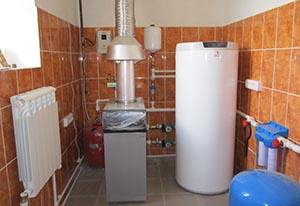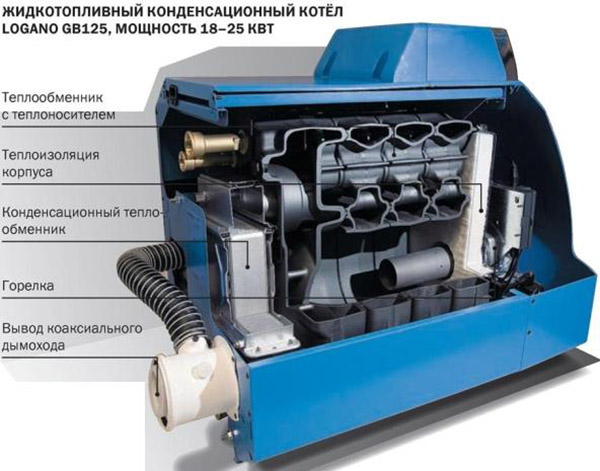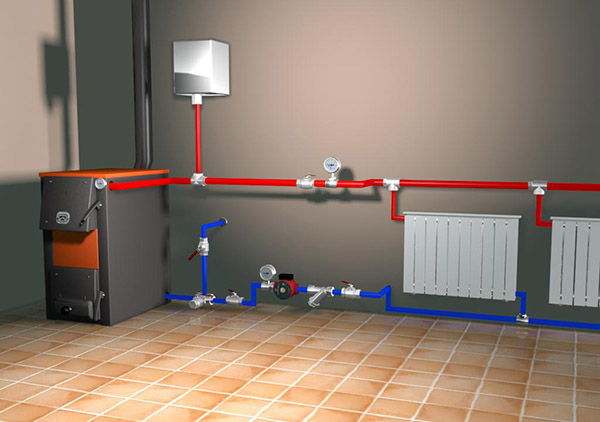What is a single-circuit and double-circuit gas boiler? Gas double-circuit boiler
Double-circuit heating boiler is a heating device with two heat exchangers, one of which is intended for heating the coolant and heating the room, and the second is intended for hot water supply.
Unlike double-circuit boilers, in single-circuit boilers only the coolant is heated.
Types of double-circuit and single-circuit boilers
Double-circuit boilers can be floor-mounted and installed on the floor or wall-mounted, designed to be attached to the wall surface. Single-circuit boilers can also be floor-mounted or wall-mounted; installation of gas boilers of this type is very simple.
Double-circuit boilers can be traditional, designed to use the lower calorific value of fuel, and condensing, designed to use the higher calorific value of fuel with the additional use of thermal energy released during condensation of water vapor.
Single-circuit boilers can also be traditional and condensation.
Depending on the design of the gas burner, both double-circuit and single-circuit boilers can have an open combustion chamber and be connected to a conventional chimney with natural draft, or have a closed combustion chamber with forced draft and a coaxial chimney.
The maximum power of double-circuit boilers is usually 24 kW. This means that it is better to install them in rooms with an area of up to 200 m2.
Construction of a double-circuit heating boiler
A double-circuit heating boiler consists of:
- Burners: devices designed to burn gas
- Two heat exchangers designed to transfer heat obtained from gas combustion to process water or coolant
- Expansion tank, designed to compensate for excess pressure that occurs when the coolant is heated
- Circulation pump ensuring the movement of coolant in the heating system
- Automatic control and security boiler operation
In double-circuit heating boilers, the priority is heating water for hot water supply. This means that when the hot water supply tap is opened, the heating of the coolant is switched off and heating begins hot water. When the hot water tap is closed, heating of the coolant begins again.
With moderate consumption of hot water for household and household needs, the coolant does not have time to cool down to a critical temperature. With high consumption of hot water in double-circuit heating boilers, the coolant can not only cool down to a critical temperature value, but also freeze. This happens especially often in private homes in winter.
To prevent emergency situations Manufacturers install antifreeze protection systems for coolant in double-circuit heating boilers, limiting hot water supply. In other words, when the temperature in the heating system drops critically, heating of water for household needs stops.
Which boiler is better, single-circuit or double-circuit?
Making a clear choice in favor of a double-circuit or single-circuit heating boiler is not as simple as it might seem at first glance. Many people believe that a double-circuit boiler is more convenient, because it provides not only heat, but also hot water. In fact, each heating boiler is designed for hot water supply. To do this, it is enough to purchase and install an indirect heating boiler.
It should be noted that with the help of this heating device (boiler) it is possible to create a more comfortable supply of hot water than when using a double-circuit heating boiler. Moreover, many manufacturers recommend equipping double-circuit heating boilers with additional indirect heating boilers, especially if we're talking about about heating water for showers or hot baths.
Usually, double-circuit boilers heating is installed in small houses with good thermal insulation, as well as in apartments with autonomous heating systems. Single-circuit boilers are preferred for heating country houses and cottages.
Air temperature is one of the main components of comfort in the home, and the choice heating system you need to approach it extremely responsibly. Heating design should be done together with the design of the house. As the “heart” of the heating system, most people choose a gas double-circuit boiler, which is available on the market in a huge number of different models.
Structure and principle of operation.
First, let's figure out what a gas double-circuit boiler is. And it is a device in which natural gas is burned, and the generated heat is transferred to water using a heat exchanger. Main components gas boiler are burner, combustion chamber, heat exchanger. The heat received in the combustion chamber is transferred to a heat exchanger, which can be made of steel or copper, and the heat exchanger transfers the received energy to water, which passes through this same heat exchanger.
What does dual-circuit mean? Why is a second circuit needed?
The second heating circuit in the boiler heats the water intended for the hot water supply system. That is, double-circuit gas boilers are used not only to create autonomous heating at home, but also to create autonomous hot water supply. Moreover, such boilers are quite often used in ordinary apartments, because many people are very annoyed when a pipe breaks somewhere on the street, and the whole house does not have hot water or the radiators stop heating. Installing a wall-mounted double-circuit boiler allows you to be independent from such central systems. All you need is gas. But what about the chimney when installing a boiler in an apartment? - you ask. The answer is simple: Coaxial chimney. This is very interesting view a chimney that allows combustion products to be discharged through the wall. And not only to remove combustion products, but also to take in from the street the air necessary for gas combustion, which means that you don’t have to worry about organizing ventilation. Such a chimney consists of two pipes, one nested inside the other. One is where air enters the boiler, and the other is where combustion products are removed.
What are the advantages of gas double-circuit boilers in relation to other types of boilers?
The main advantage of gas double-circuit boilers in gas. After all, this type of fuel is very cheap, and heating a private house using gas will be much less expensive than, say, using electricity or diesel fuel. That is why many owners of country houses are inclined towards gas heating.
Another advantage of this type of boiler is its autonomy. Modern models are equipped with an automatic control system, which will regulate the temperature depending on the time of day, and will notify you in the event of a breakdown, and will turn off the boiler itself in the event of any serious malfunction. In general, modern gas double-circuit boilers are very convenient heating devices, unpretentious in operation and very reliable.
Installation of a double-circuit gas boiler.
As mentioned above, there are two types of double-circuit gas boilers - wall-mounted and floor-mounted. To install a floor-standing version of a double-circuit gas boiler, you will need a separate room - a boiler room. Indeed, according to GOSTs and safety regulations, such a unit must be isolated. A constant flow of fresh air must be organized into the boiler room - ventilation, but this does not apply to cases when a coaxial chimney is connected to the boiler - because in this case, the air comes from outside the house, oxygen from the room will not be wasted.
Installation of a wall-mounted version of a double-circuit gas boiler does not require a separate room. Such boilers have a small power and size, and can easily be installed in residential premises, for example, in the kitchen. A large selection of models will allow you to choose a boiler not only of the required power, but also of the required appearance, which will fit perfectly into your interior. Many people are concerned about the noise level of such a boiler. There is no need to worry about this - a wall-mounted boiler operates no louder than a refrigerator, and after a while you will stop paying attention to it altogether.
1.
2.
3.
4.
The desire of residents of large cities to have their own cottage in the suburbs is understandable, since clean air is much preferable to smog and vehicle emissions. To make life in a private house comfortable, its owner will need to ensure the reliable functioning of utilities, including the heat supply system.
Creating a heating network is entirely a problem for the residents of the household, and they will have to solve it themselves. As a result, you will need to purchase heating equipment that is reliable, durable, easy to adjust and control, and affordable. These are the parameters that correspond to double-circuit solid fuel boilers, the image of which can be seen in the photo.
general information
Double-circuit ones are intended for heating rooms. These devices can operate on wood, coal, biofuel from wood waste, etc. Today, double-circuit solid fuel boilers are considered a relatively inexpensive and reliable option for heating a home and providing hot water.
- with a boiler built into the device;
- with built-in coil.
To make it possible to regulate the temperature in the boiler, this equipment should be connected together with a boiler boiler, the so-called indirect heating, which has a built-in coil that passes hot water from the unit through itself (more details: " "). In this case, this element of the device performs the function of a heat exchanger and is mounted in such a way that uniform heating of the liquid is ensured. Since the heat exchanger has a large surface area, the water becomes hot in a short period of time.

The difference between single-circuit and double-circuit solid fuel boilers
To understand the differences between a double-circuit solid fuel boiler and a single-circuit unit, you should know that in the second version the device is intended exclusively for heating a house. The design includes a heating coil and coolant.Thus, if you install a single-circuit device, then in order to provide residents with hot water for domestic needs, it will be necessary to come up with another option. The coolant in a single-circuit solid fuel unit can be either water or special antifreeze.
As for solid fuel double-circuit heating boilers, they are assigned two functions - supplying heat to the premises and heating water. The structural solution of such units involves the presence of two spirals. A long-burning double-circuit solid fuel boiler heats the water, which moves through a pipeline laid in the room, gives off heat and returns to the device, from where it is sent to the water supply.

Pros and cons of a solid fuel double-circuit boiler
Like other heating devices, dual-circuit solid fuel boilers long burning have a number of advantages and disadvantages.Among the advantages it should be noted:
- affordable price heating equipment and its inexpensive operation;
- Ease of use;
- reliability in operation;
- possibility to apply different kinds solid fuel, including wood, coal, peat, pellets, etc. (read also: " ");
- economical operation;
- inexpensive maintenance;
- ability to monitor the performance of the heating system on our own, without involving specialists whose services cost a lot of money;
- Every owner of a private home can study the instructions and carry out installation.
- fuel can only be added to the corresponding chamber manually;
- it is not possible to adjust the temperature of the liquid;
- space required to store fuel;
- the need to dry the firewood before loading it into the compartment.

Operating principle of a solid fuel boiler
The operating principle of a heating device operating on different types solid fuel cannot be called particularly complex. The purpose of the main circuit is to maintain a stable temperature in the pipeline. When the temperature drops, the detector sensor is activated.The second circuit must maintain the coolant temperature. A sensor installed inside the water storage tank instantly reacts to its cooling. After receiving signals from both sensors, a long-burning double-circuit solid fuel boiler burns fuel, after which heat is released and the water in the circuits is heated.
Earlier in the article it was said that quite often such units are connected to an additional capacity, namely a boiler. As a result, consumers not only save on fuel, but also provide the home and people living in it with a stable hot water supply that does not depend on the water pressure in the pipes. Therefore, before you go shopping for a boiler, you should think about buying a boiler.
Watch a video about choosing a solid fuel double-circuit boiler:
Depending on the place in the house where you plan to install the heating boiler, choose a wall-mounted or floor-standing model, taking into account the dimensions of the unit and the size of the room (read: "").
The heating boiler ensures the correct functioning of closed heating networks during the heating season.
Additional functions may include providing hot water supply and combining a heating boiler with a boiler.
Heating boilers by fuel type - how to choose?
The most common double-circuit heating boilers are gas. They are also the most economical to use; the choice of gas heating boilers is very wide. Both floor and wall, with or without a boiler, for any volume, from a variety of manufacturers.

Double-circuit gas boiler
A significant part of boilers depend on both a gas source and electricity, on which all automation operates.
A gas boiler is the best choice if gas is supplied.
Liquid fuel
Heating boilers running on liquid fuel have a similar structure to gas boilers, but the choice is much smaller.

Liquid fuel boiler design
Coal
Solid fuel boilers are reliable, inexpensive to use, but also have a number of serious disadvantages. In addition, heating with coal is unprofitable in most regions.
If you can arrange coal supply good quality and ensure the storage and supply of coal (this is a rather complex and cumbersome design), then this option can also be taken into consideration. Many boiler houses operate perfectly on coal, providing uninterrupted heat to entire cities.

Sectional diagram of a solid fuel boiler
The disadvantage of the industrial use of coal as fuel is its low environmental friendliness. The smoke exhaust pipe will have to be built quite high.
Electrical
Electric heating boilers are the most expensive to operate, but with an autonomous source of electricity, they provide complete independence from communications. A rather eccentric option, but if the alternative is stove heating with walks in the forest for firewood, then it is quite interesting to consider.

It makes sense if you have enough money to install several wind turbines, the area is windy, you have good practical skills as an electrical engineer and are concerned about cleanliness of the environment.
The main heating option for a private home is gas single-circuit and double-circuit boilers. Other options at this moment are considered as extremely uneconomical exotics. Stove heating is common in villages; firewood is purchased in the fall and stored under special sheds. For wood heating of a small house, a car of firewood is required for the season, without taking into account the installation of a bathhouse.
What is the difference between single-circuit and double-circuit heating boilers?
Very simple. One circuit - the boiler works as a heating device. Hot water flows only into the heating circuit. The contour in this case is a closed line.

Single-circuit and double-circuit boilers - differences
A double-circuit boiler operates by supplying hot water to the heating network circuit and, additionally, to the hot water supply circuit.
Double-circuit boilers are more economical; the function of heating water for domestic needs is additional, therefore such boilers are the most common.
During the warm season, the water supply to the heating circuit may be interrupted.
Flow or boiler?
Water supply to the domestic circuit can be carried out both in flow mode and in the mode of installing an additional boiler.
Flow mode provides economical heating of water without a storage tank, as needed.
The average productivity of this mode is 10-20 liters of hot water per minute.
You can wash your hands or quickly wash your hair, but it will be difficult to enjoy the hot streams in the shower. In most models, when hot water is supplied to the water supply system, the supply of hot water to the heating network is turned off. This is not very convenient. Usually a boiler tank is installed, the capacity of which is up to 200 liters. A 100 liter boiler is enough for a comfortable stay for 2 people.
 If you're installing home heating, you might be interested in learning about other ways to heat a room. Installing a heated floor from the point of view of energy efficiency - how to save electricity and calculate heating costs?
If you're installing home heating, you might be interested in learning about other ways to heat a room. Installing a heated floor from the point of view of energy efficiency - how to save electricity and calculate heating costs?
Read about the pros and cons of plastic sewer pipes.
Lifehacks from heating engineers
 Installing an autonomous electric generator and connecting it as an emergency power source contributes not only to the uninterrupted supply of heat, but also to the safety of equipment.
Installing an autonomous electric generator and connecting it as an emergency power source contributes not only to the uninterrupted supply of heat, but also to the safety of equipment.
If the electric generator and the boiler operate on the same type of fuel, for example, diesel fuel, and the automation of the boiler is reduced to a minimum, refueling the boiler and generator solves the problem of starting the equipment in the absence of electricity.
The presence of electricity generators or charged batteries is a prerequisite for autonomous existence. Electricity ensures the start of all systems, heating, water pumps, and other equipment, including heating sewer pipes. Therefore, “crazy” ideas for eco-friendly houses with wind turbines and solar panels
on the rooftops are not so crazy upon closer inspection.
